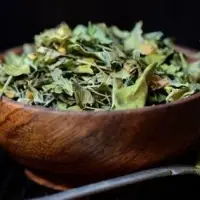
M. oleifera is a fast-growing, deciduous tree that can reach a height of 10 -12 m (32- 40 ft) and trunk diameter of 45 cm (1.5 ft). The bark has a whitish-grey colour and is surrounded by thick cork. Young shoots have purplish or greenish-white, hairy bark. The tree has an open crown of drooping, fragile branches and the leaves build up a feathery foliage of tripinnate leaves. The flowers are fragrant and hermaphroditic, surrounded by five unequal, thinly veined, yellowish-white petals. The flowers are about 1.0 - 1.5 cm (1/2) long and 2.0 cm (3/4) broad. They grow on slender, hairy stalks in spreading or drooping flower clusters which have a length of 10 -25 cm. Flowering begins within the first six months after planting. In seasonally cool regions, flowering only occurs once a year between April and June. In more constant seasonal temperatures and with constant rainfall, flowering can happen twice or even all year-round. The fruit is a hanging, three-sided brown capsule of 20 - 45 cm size which holds dark brown, globular seeds with a diameter around 1 cm. The seeds have three whitish papery wings and are dispersed by wind and water. In cultivation, it is often cut back annually to 1 - 2 m (3 - 6 ft) and allowed to regrow so the pods and leaves remain within arm' s reach.
M. oleifera is a fast-growing, deciduous tree that can reach a height of 10 - 12 m (32 - 40 ft) and trunk diameter of 45 cm (1.5 ft). The bark has a whitish-grey colour and is surrounded by thick cork. Young shoots have purplish or greenish-white, hairy bark. The tree has an open crown of drooping, fragile branches and the leaves build up a feathery foliage of tripinnate leaves. The flowers are fragrant and hermaphroditic, surrounded by five unequal, thinly veined, yellowish-white petals. The flowers are about 1.0 - .5 cm (1/2) long and 2.0 cm (3/4 ) broad. They grow on slender, hairy stalks in spreading or drooping flower clusters which have a length of 10 - 25 cm. Flowering begins within the first six months after planting. In seasonally cool regions, flowering only occurs once a year between April and June. In more constant seasonal temperatures and with constant rainfall, flowering can happen twice or even all year-round. The fruit is a hanging, three-sided brown capsule of 20â??45 cm size which holds dark brown, globular seeds with a diameter around 1 cm. The seeds have three whitish papery wings and are dispersed by wind and water. In cultivation, it is often cut back annually to 1 - 2 m (3 - 6 ft) and allowed to regrow so the pods and leaves remain within arm's reach.
M. oleifera is a fast-growing, deciduous tree that can reach a height of 10 - 12 m (32 - 40 ft) and trunk diameter of 45 cm (1.5 ft). The bark has a whitish-grey colour and is surrounded by thick cork. Young shoots have purplish or greenish-white, hairy bark. The tree has an open crown of drooping, fragile branches and the leaves build up a feathery foliage of tripinnate leaves. The flowers are fragrant and hermaphroditic, surrounded by five unequal, thinly veined, yellowish-white petals. The flowers are about 1.0 - 1.5 cm (1/2) long and 2.0 cm (3/4) broad. They grow on slender, hairy stalks in spreading or drooping flower clusters which have a length of 10 - 25 cm. Flowering begins within the first six months after planting. In seasonally cool regions, flowering only occurs once a year between April and June. In more constant seasonal temperatures and with constant rainfall, flowering can happen twice or even all year-round. The fruit is a hanging, three-sided brown capsule of 20â??45 cm size which holds dark brown, globular seeds with a diameter around 1 cm. The seeds have three whitish papery wings and are dispersed by wind and water. In cultivation, it is often cut back annually to 1 - 2 m (3 - 6 ft) and allowed to regrow so the pods and leaves remain within arm's reach.


